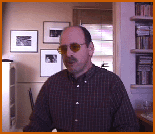|
return
to page
1
of conversation
Michael
:
So it's not just the voice itself, but the fact of working that
way, without using your eyes to scan the words on the page, that
makes reading and writing difficult?
|
|
Joel
:
Like a child, I appreciate being read to, even by a computer
with a voice like your worst dystopian nightmare. The problem
is that I can't scan backward and forward visually to check
details, to maintain a sense of context, and to enjoy optimal
recall when that text, vocalized, is in the air and gone, to
paraphrase Eric Dolphy's remark on the ephemerality of music.
Writing is really a challenge. Monitoring the flow of thought,
the coherent use of imagery, the rhythm and melody of the language.
I used to observe as I typed, correcting course instantaneously,
doubling-back to tweak something and then plunging forward again.
And knowing that even the most sprawling first draft could always
be
|
|

Joel
on the difficulty of reading and writing
|
|
|
inspected
later, visually, to see the sculpture leapout from within the
superfluous stone. Now I have to plan meticulously, holding
a kind of sketch in my mind, filling it in as I go, and committing
each particle of thought and language to memory.
|
|
|
Michael
:
In what ways do you think this new method of working affects the
finished product, the final draft of a piece of writing?
|
|
Joel
:
Writing without being able to see the words I type can yield unexpectedly
good results or produce horribly dull, pointless prose. At best,
I may wind up with an essay or story in which every word, image,
and thought seems inevitable, and the overall effect coherent and
convincing, even moving. But all too often, what I get is something
very stiff, and a little bit off, like someone who shows up at a
rave in an ill-fitting tuxedo. At which point, regardless of how
much concentration and time I've already expended, I've achieved
nothing more than a first draft.
|
Joel
:
The device you remember was a closed circuit TV reading system
(CCTV). Some CCTV's use your computer's screen for display,
but most have their own monitors, mounted above a movable reading
table on which the camera lens is focused. This is the type
I have now. I use it mostly for examining bills, reading snail
mail, and CD liner notes. At first, I used a CCTV to read entire
books, but now the glare (unnoticeable to normal eyes) and the
extreme magnification needed to keep print from looking as if
it's been chewed up by insects makes this impossible. The talking
computer trick is done with a text-to-speech system, a screen
reader. Mine is called Jaws for Windows, from the Henter-Joyce
|
|

Joel on using CCTV.
|
|
|
Company. Jaws lets me perform all computer tasks, including
e-mail and Web surfing. The technology emerged in the days of
the text-based DOS operating system. Later, developers had to
scramble to adapt the concept to the graphical interface of
a Windows or MAC display, find menu alternatives to the icons
and keyboard equivalents to mouse commands. Despite the robot-like
synthesized voice and, more importantly, the profound adjustments
required for reading and especially for writing by ear, I love
this thing, and can't imagine life without it.
|
|
|







